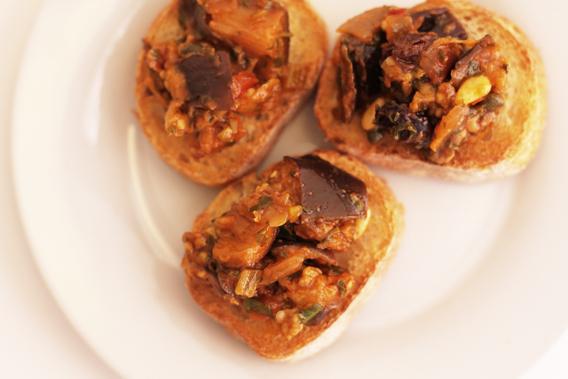In its natural state, eggplant is tough, spongy, and bitter—pretty vile, all in all. Generally, vegetables (especially ones with a reputation for being vile) do not benefit from overcooking—think fetid Brussels sprouts, gray peas, floppy asparagus. Eggplant is the opposite: Its unpleasantness is directly correlated with how undercooked it is. I would rather go hungry than eat a grill-marked yet stiff slice of eggplant—which is how eggplant is traditionally served in workplace cafeterias, airport sandwich kiosks, and other venues that don’t pride themselves on their vegetarian offerings. But eggplant so mushy it falls apart when you so much as prod at it gently with a finger? Eggplant so tender that stabbing it with a fork with your eyes closed feels no different from stabbing a patch of empty space? Now we’re talking.
Cooking eggplant until it’s quiveringly soft will only take you so far, though. There’s still the issue of flavor to address—and though cooked eggplant is less bitter than raw eggplant, its mild earthiness isn’t known for making mouths water. But that fundamental blandness is a perfect foil for more assertive ingredients. The best complement for eggplant is some combination of sweet, salty, and tangy. (It goes without saying that fat doesn’t hurt, either.) There are a few ways of achieving this combination: Think of takeout Chinese eggplant, lacquered with a glaze containing soy sauce, sugar, and rice vinegar, for instance. But the best preparation of eggplant is one that not only maximizes its flavor potential but also takes advantage of that silky texture: eggplant caponata.
This Sicilian spread (also perfectly respectable served as a salad) is the savory equivalent of a kitchen-sink cookie; you’ll find no recipe that combines olives, capers, raisins, sugar, lemon, and parsley to greater effect. Its technique is no less unconventional: First you fry eggplant in copious amounts of olive oil (extra-virgin works, though you have to take care to keep it from smoking; light olive oil is also fine). Then you combine the eggplant with moist ingredients and serve it cool. Typically, fried foods are best served fresh out of the frying pan—but caponata’s delayed-gratification approach works precisely because the eggplant becomes super-soft, rather than crisp, when fried. (Frying also happens to be a much faster way of making eggplant meltingly tender than roasting, grilling, or baking.)
The frying process has to occur in a few batches, since the biggest mistake you can make while frying is to overcrowd your ingredients in the oil. This means caponata demands a leisurely attitude, more “I Am Trying to Break Your Heart” than “Kamera.” It’s a weekend-afternoon project, not a weeknight one—and, appropriately, it’s the perfect thing to serve atop bruschetta at your next weekend cocktail party.
Eggplant Caponata
Yield: 6 to 8 servings
Time: 1½ to 1¾ hours
Olive oil for frying
2 medium eggplants (about 2 pounds), cut into 1-inch cubes
Salt
1 large yellow onion, chopped
3 celery stalks, chopped
6 garlic cloves, minced
Black pepper
¼ cup tomato paste
3 fresh Roma tomatoes, chopped
½ cup chopped green olives
⅓ cup raisins
¼ cup red wine vinegar
2 tablespoons sugar
2 tablespoons capers
¼ teaspoon crushed red pepper
¼ cup pine nuts
1 small bunch parsley, chopped, thick stems discarded
Juice of 1 lemon
1. Put 1½ inches of olive oil in a large, deep pot over medium-high heat. Add a cube of the eggplant to the oil to test whether it’s hot enough; the oil should sizzle. Working in batches, add the eggplant and fry, stirring occasionally, until lightly browned and fully tender, 10 to 12 minutes. Transfer to paper towels to drain, and season with salt.
2. Carefully strain the oil into a glass container and wipe out the pot. Return ¼ cup of the oil to the pan over medium-high heat (reserve the rest for another use), and add the onion, celery, and garlic; season with salt and pepper. Cook, stirring occasionally, until soft and golden brown, about 15 minutes. Add the tomato paste and continue cooking, stirring constantly, until fragrant and lightly caramelized, about 3 minutes.
3. Reduce the heat to medium and add the tomatoes, olives, raisins, vinegar, sugar, capers, crushed red pepper, and ¼ cup water. Cook, stirring frequently, until the tomatoes begin to break down, 15 to 20 minutes. Meanwhile, put the pine nuts in a large skillet over medium heat and cook, stirring often, until lightly browned, 3 to 5 minutes.
4. Turn off the heat under the tomato mixture, and stir in the pine nuts, parsley, lemon juice, and eggplant. Taste and adjust the seasoning. Cool to room temperature and serve. (Store leftover caponata in an airtight container in the refrigerator for up to several days.)
Previously in You’re Doing It Wrong:
Polenta
Broccoli
Olives
Kale
Ratatouille
Zucchini
Brussels Sprouts
